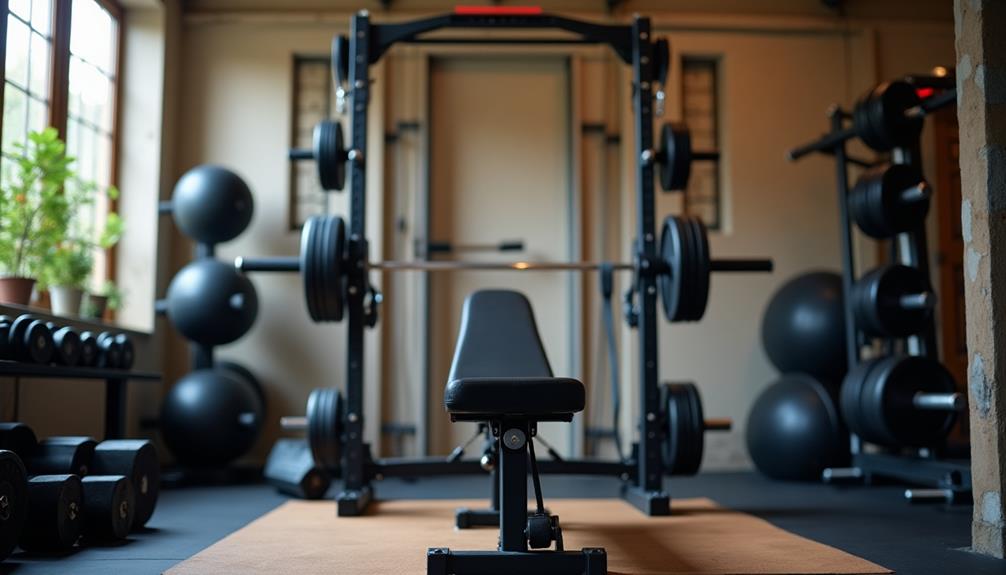To build back strength with resistance training, start by targeting key muscle groups like your lats, glutes, and hamstrings. Use equipment such as dumbbells and resistance bands for varied resistance. Incorporate effective exercises, like deadlifts and rows, performing 2-3 sets of 8-12 reps. Maintain proper form to prevent injuries and prioritize your warm-up with dynamic stretches. Consistency is key, so schedule workouts throughout the week and allow time for recovery. Don't forget to include mobility and flexibility work, as it enhances overall performance. By focusing on these areas, you'll gain strength and functionality essential for daily activities. There's more to explore!
Core Insights
- Focus on compound movements like deadlifts and squats to engage multiple muscle groups for effective back strength training.
- Use resistance bands and dumbbells to provide versatile options and gradually increase resistance as your strength improves.
- Target key muscle groups such as lats, core, and glutes to build a strong foundation for back support and stability.
- Incorporate dynamic stretching and light cardio as warm-ups to prepare muscles and prevent injuries during resistance training.
- Include post-workout static stretching and foam rolling to enhance flexibility, reduce soreness, and improve recovery.
Importance of Back Strength

Back strength is necessary for overall health and functionality. A strong back supports your spine, reducing the risk of injuries and discomfort. It plays a pivotal role in maintaining good posture, which can enhance your appearance and boost confidence. When your back muscles are strong, daily activities like lifting, bending, and even sitting become easier and more efficient. Incorporating resistance band exercises into your routine can effectively target and strengthen your back muscles, offering a versatile and convenient way to improve back strength at home or while traveling.
Additionally, back strength contributes to athletic performance. Whether you're running, swimming, or playing sports, a strong back helps stabilize your core, allowing for better movement and coordination. It's crucial to recognize that weak back muscles can lead to imbalances that may cause pain and strain. By prioritizing back strength, you're investing in your long-term health and improving your overall quality of life.
Understanding Resistance Training

When starting, focus on proper form and technique. This helps prevent injuries and guarantees you're targeting the right muscles. Resistance bands are an excellent alternative to traditional weights, offering versatile and effective options for building back strength. Gradually increase the weight or resistance as you become stronger. Aim for consistency, with workouts spread throughout the week. Remember, recovery is just as crucial as the workouts themselves. Give your muscles time to heal and grow stronger.
Key Muscle Groups to Target

To build back strength effectively, it's important to focus on key muscle groups that support your overall stability and performance. Start with your core, as a strong core stabilizes your spine and enhances your posture. Next, pay attention to your glutes; these muscles power many movements and help protect your lower back. Don't forget your lats, which play a pivotal role in upper body strength and stability during pulling exercises. Incorporating exercises that target your shoulders will also improve your overall upper body strength. Using stackable resistance tubes can help you progressively increase the challenge as you build strength in these muscle groups. Resistance tubes offer a versatile and portable option for targeting specific muscle areas with varying levels of resistance. Finally, engage your hamstrings to support your legs and help balance your muscle development. By focusing on these muscle groups, you'll set a solid foundation for building back strength and improving your performance in various activities.
Essential Equipment for Training

Choosing the right training equipment is essential for maximizing your resistance training results. Start with a set of dumbbells. They're versatile and allow you to perform a range of exercises targeting your back muscles. Resistance bands are another great option; they're portable and perfect for adding variable resistance. If you prefer a more structured approach, consider a cable machine. It offers adjustable tension and different angles for exercises. A stability ball can also enhance your workouts by improving your core strength and stability. Finally, don't overlook a sturdy mat for floor exercises. By selecting the right equipment, you'll create a well-rounded training routine that effectively strengthens your back while keeping things engaging and efficient.
Effective Resistance Exercises

Effective resistance exercises are essential for building strength and improving overall fitness. To get started, focus on compound movements like squats, deadlifts, and bench presses. These exercises engage multiple muscle groups, maximizing your workout efficiency.
Incorporate bodyweight exercises such as push-ups and lunges, which require no equipment and can be done anywhere. Resistance bands can also add variety and intensity to your routine, allowing for a wider range of motion.
Don't forget about isolation exercises like bicep curls and tricep extensions. These help target specific muscles for balanced development. Aim for 2-3 sets of 8-12 repetitions for each exercise. By consistently integrating these effective resistance exercises, you'll build back strength and enhance your overall fitness journey.
Proper Form and Technique

Mastering proper form and technique is crucial for maximizing the benefits of resistance training while minimizing the risk of injury. By focusing on your form, you establish effective muscle engagement and reduce strain on your joints. Here are some key points to remember:
- Keep your core engaged to stabilize your body throughout the movement.
- Maintain a neutral spine; avoid rounding or arching your back.
- Utilize a full range of motion to fully activate your muscles.
- Manage your movements; avoid using momentum to lift weights.
- Breathe properly; exhale during exertion and inhale during the release.
Creating a Balanced Workout Plan

A well-structured workout plan is necessary for achieving balanced strength and overall fitness. Start by including exercises that target all major muscle groups: legs, back, chest, arms, and core. Aim for at least two sessions per week for each group.
Next, mix different types of resistance training—free weights, machines, and bodyweight exercises—to keep workouts varied and engaging. Don't forget to incorporate flexibility and mobility work, as these are vital for recovery and injury prevention.
Lastly, schedule rest days to allow your muscles to recover and grow stronger. By following these guidelines, you'll create a balanced workout plan that not only builds back strength but also promotes overall fitness and well-being.
Progression and Tracking Strength
To truly build back strength, it's important to focus on progression and tracking your performance. By monitoring your workouts, you can see how far you've come and adjust your routine accordingly. Here are some effective ways to track your progress:
- Keep a workout journal to log exercises, sets, and reps.
- Use a progress tracker app to visualize your strength gains over time.
- Take regular photos to see physical changes in your body.
- Record your weights to validate you're gradually increasing resistance.
- Set specific goals and milestones to keep you motivated.
With these strategies, you'll not only stay accountable but also celebrate your achievements, making your strength-building journey more rewarding.
Injury Prevention Strategies

Injury prevention is essential for anyone looking to build back strength safely and effectively. Start by warming up properly. A good warm-up increases blood flow and prepares your muscles for exercise. Next, focus on proper form. Using the correct technique helps avoid unnecessary strain on your back. Gradually increase the weight you lift, listening to your body to prevent overexertion. Incorporate rest days into your routine to allow your muscles time to recover. Don't forget to stay hydrated as well; dehydration can lead to muscle cramps and fatigue. To wrap it up, consider cross-training. Engaging in different activities helps balance muscle development and reduces the risk of injury. By following these strategies, you can enhance your strength training while minimizing your injury risk.
Incorporating Mobility and Flexibility

To integrate mobility and flexibility into your training, consider the following:
- Dynamic stretching before workouts to warm up muscles
- Static stretching post-workout for muscle relaxation
- Yoga sessions to enhance overall flexibility and mindfulness
- Foam rolling to release muscle tension and improve circulation
- Regular mobility drills to maintain joint health
Frequently Asked Questions
How Often Should I Train My Back for Optimal Strength?
To optimize back strength, you should train it two to three times a week. This frequency allows for adequate recovery while promoting muscle growth. Just make sure you're varying your exercises to target all areas effectively.
Can Resistance Training Help With Posture Improvement?
Did you know that 80% of people experience back pain at some point? Resistance training strengthens your muscles, improving posture and reducing discomfort. You'll notice better alignment, greater confidence, and enhanced overall health with consistent effort.
What Are Common Mistakes During Back Resistance Training?
You might overlook proper form, rush through exercises, or use too much weight, leading to injury. Failing to warm up or neglecting balanced training can also limit your progress and effectiveness in back resistance training.
How Do I Know if I'm Overtraining My Back?
You'll know you're overtraining your back if you experience persistent soreness, fatigue, decreased performance, or increased injuries. Pay attention to how your body feels, and don't hesitate to take breaks when needed.
Are There Age Restrictions for Starting Back Resistance Training?
There aren't strict age restrictions for starting back resistance training. At any age, you can begin safely, provided you consult with a healthcare professional and tailor your routine to your fitness level and goals.

